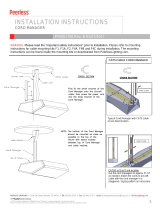
Contents
ii
Modula Instruction Manual
S-Video Boards ................................................................................................. 59
Applicability Notice ...............................................................................................................59
S-Video Boards Specifications ...............................................................................................61
Attaching Cables ...................................................................................................................63
RGBHV/HD-15 Boards ...................................................................................... 65
Applicability Notice ...............................................................................................................65
RGBHV/HD-15 Specifications.................................................................................................66
Attaching Cables ...................................................................................................................67
RGBHV+Stereo to CatPro Boards with TXs & RXs............................................ 69
Applicability Notice ...............................................................................................................69
RGBHV+Stereo to CatPro Boards Specifications ...................................................................71
CatPro RGBHV+Stereo RX and TX Modules Specifications ...................................................72
Attaching Cables and Wires................................................................................................... 74
CatPro System Equipment..................................................................................................... 77
System Setup......................................................................................................................... 78
Cabling and Video Display Adjustment .................................................................................81
Troubleshooting ....................................................................................................................92
Stereo Audio Boards ........................................................................................ 93
Applicability Notice ...............................................................................................................93
Stereo Audio Boards Specifications.......................................................................................95
Attaching Wires .....................................................................................................................99
Adjusting Output Volume....................................................................................................100
Adjusting Input Gain............................................................................................................101
Mono Audio Boards........................................................................................ 103
Applicability Notice .............................................................................................................103
Mono Audio Boards Specifications ......................................................................................106
Attaching Wires ...................................................................................................................109
Adjusting Output Volume....................................................................................................110
Adjusting Input Gain............................................................................................................111
Microphone Input and Phantom Power Boards .............................................. 113
Applicability Notice .............................................................................................................113
Microphone Input and Phantom Power Board Specifications..............................................114
Compression Ratio...............................................................................................................114
Attaching Wires ...................................................................................................................116
Turning the Microphone Input Board On.............................................................................116
Board Settings .....................................................................................................................117
SD-SDI and HD-SDI Digital Video Boards ....................................................... 119
Applicability Notice .............................................................................................................119
SD-SDI and HD-SDI Digital Video Board Specifications .......................................................120
Attaching Cables .................................................................................................................121




















